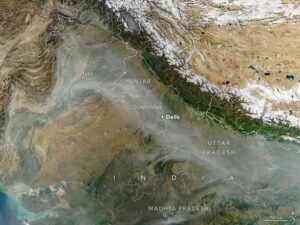A new study from the University of Surrey has found that evergreen trees with smaller leaves are the most efficient trees at removing pollution from the air.
Titled: A trait-based investigation into evergreen woody plants for traffic-related air pollution mitigation over time, the study involved researchers from Surrey’s Global Centre for Clean Air Research (GCARE) testing ten trees beside a busy main road, studying which caught the most particles of pollution and which best allowed the rain to wash those particles safely to the ground.
It had been thought that leaves with rougher surfaces and minute hairs would catch more pollutants. Yet that wasn’t borne out by the evidence.
Yendle Barwise, former forester and University of Surrey researcher, said: ‘When tackling air pollution, the ideal leaves cling on to particles when it’s windy – but let go of them in the rain. That means the wind blows less pollution back into the air – but rain can wash it safely to the ground.
‘Being rough and hairy isn’t all it’s cracked up to be. To remove more particle pollutants over time, leaves need to be washed by rainfall, and it seems that the size and shape of the leaf is much more important from this perspective.’
Previous studies have tended to use deciduous species of trees but recent review papers have indicted that green infrastructure should improve air quality throughout the year, particularly given that air pollution levels are often higher in winter than in summer.
For this reason, the scientists chose ten evergreen specimens and placed them in plant pots beside the A3 in Guildford, past which around 80,000 vehicles drive every day.
Of those studied, Yew was the plant which removed most air pollution. The most effective leaf types were awl-shaped, as found on the Japanese Cedar and Lawson’s Cypress.
The study also suggested that stomata – the ‘pores’ of the leaf – could help plants catch particles. For Yew, more particles of pollution gathered on the porous underside of the leaf. That’s despite the other side of the leaf being 47% rougher, which was previously assumed to a significant benefit in catching pollution.
In fact, the team speculated that this roughness may in fact hinder net removal over time and that small leaf area may be advantageous in terms of both accumulation and wash-off efficacy, delivering efficient capture and recapture capacity across rainfall events.
Professor Prashant Kumar, founder of the University of Surrey’s Global Centre for Clean Air Research, said: ‘We know that planting trees by roadsides can make a big difference to air quality. Our study shows that by choosing your trees carefully, that difference can be even bigger.”
‘We’ve shown that smarter choice of plants can take even more pollution out of the air. We just studied the shapes and textures of the leaves themselves. Other factors, like the tree’s height, leaf chemistry, or how many trees you plant, could also make a big difference. Those are well worth investigating in the future.’
The researchers have deliberately not produced a ‘best to worst’ for fear that this would encourage inappropriate species selection, concluding: ‘Future research regarding the nuanced and plant species- or trait-specific relationship between rainfall intensity and particle wash-off, particularly involving leaf biophysical and chemical traits not investigated as part of the present study, is highly recommended.’

















Not identifying the best tree for removal of particles is understandable. It would be helpful for we tree planters if some idea of the scale of removal accomplished by the trees could be given.